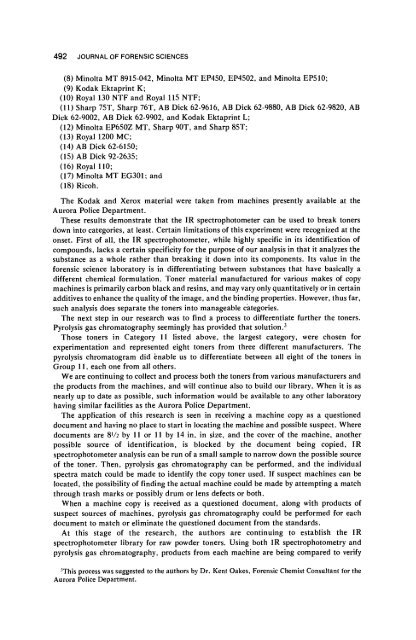Preliminary Examination of Machine Copier Toners by ... - Library
Preliminary Examination of Machine Copier Toners by ... - Library
Preliminary Examination of Machine Copier Toners by ... - Library
Create successful ePaper yourself
Turn your PDF publications into a flip-book with our unique Google optimized e-Paper software.
492 JOURNAL OF FORENSIC SCIENCES<br />
(8) Minolta MT 8915-042, Minolta MT EP450, EP4502, and Minolta EPSI0;<br />
(9) Kodak Ektaprint K;<br />
(10) Royal 130 NTF and Royal 115 NTF;<br />
(11) Sharp 75T, Sharp 76T, AB Dick 62-9616, AB Dick 62-9880, AB Dick 62-9820, AB<br />
Dick 62-9002, AB Dick 62-9902, and Kodak Ektaprint L;<br />
(12) Minolta EP650Z MT, Sharp 90T, and Sharp 8ST;<br />
(13) Royal 1200 MC;<br />
(14) AB Dick 62-6150;<br />
(15) AB Dick 92-2635;<br />
(16) Royal 110;<br />
(17) Minolta MT EG301; and<br />
(18) Ricoh.<br />
The Kodak and Xerox material were taken from machines presently available at the<br />
Aurora Police Department.<br />
These results demonstrate that the IR spectrophotometer can be used to break toners<br />
down into categories, at least. Certain limitations <strong>of</strong> this experiment were recognized at the<br />
onset. First <strong>of</strong> all, the IR spectrophotometer, while highly specific in its identification <strong>of</strong><br />
compounds, lacks a certain specificity for the purpose <strong>of</strong> our analysis in that it analyzes the<br />
substance as a whole rather than breaking it down into its components. Its value in the<br />
forensic science laboratory is in differentiating between substanees that have basically a<br />
different chemical formulation. Toner material manufactured for various makes <strong>of</strong> copy<br />
machines is primarily carbon black and resins, and may vary only quantitatively or in certain<br />
additives to enhance the quality <strong>of</strong> the image, and the binding properties. However, thus far,<br />
such analysis does separate the toners into manageable c~ttegories.<br />
The next step in our research was to find a process to differentiate further the toners.<br />
Pyrolysis gas chromatography seemingly has provided that solution. 3<br />
Those toners in Category 11 listed above, the largest category, were chosen for<br />
experimentation and represented eight toners from three different manufacturers. The<br />
pyrolysis chromatogram did bnable us to differentiate between all eight <strong>of</strong> the toners in<br />
Group I I, each one from all others.<br />
We are continuing to collect and process both the toners from various manufacturers and<br />
the products from the machines, and will continue also to build our library. When it is as<br />
nearly up to date as possible, such information would be available to any other laboratory<br />
having similar facilities as the Aurora Police Department.<br />
The application <strong>of</strong> this research is seen in reeeiving a machine copy as a questioned<br />
document and having no place to start in locating the machine and possible suspect. Where<br />
documents are 8~/2 <strong>by</strong> 11 or 11 <strong>by</strong> 14 in. in size, and the cover <strong>of</strong> the machine, another<br />
possible source <strong>of</strong> identification, is blocked <strong>by</strong> the document being copied, IR<br />
spectrophotometer analysis can be run <strong>of</strong> a small sample to narrow down the possible source<br />
<strong>of</strong> the toner. Then, pyrolysis gas chromatography can be performed, and the individual<br />
spectra match could be made to identify the copy toner used. If suspect machines can be<br />
located, the possibility <strong>of</strong> finding the actual machine could be made <strong>by</strong> attempting a match<br />
through trash marks or possibly drum or lens defects or both.<br />
When a machine copy is received as a questioned document, along with products <strong>of</strong><br />
suspect sources <strong>of</strong> machines, pyrolysis gas chromatography could be performed for each<br />
document to match or eliminate the questioned document from the standards.<br />
At this stage <strong>of</strong> the research, the authors are continuing to establish the IR<br />
spectrophotometer library for raw powder toners. Using both IR spectrophotometry and<br />
pyrolysis gas chromatography, products from each machine are being compared to verify<br />
-~This process was suggested to the authors <strong>by</strong> Dr. Kent Oakes, Forensic Chemist Consultant tor the<br />
Aurora Police Department.

















